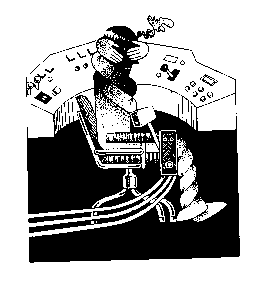
| "Our industry was a social jungle and the workers in the jungle were nameless, faceless clock cards. They had no protection and they were the victims of an inhuman speed-up... This union was not born just because of the struggle for another dollar in the pay envelope. This union was born out of the struggle against the inhuman exploitation of the speed-up in the automobile industry and other industries." Walter Reuther |
"It is alarming that in the closing years of this century our workplaces are reverting to working conditions we are more likely to associate with the beginning of the century. Employers have gone too far. For the sake of competitiveness, in the name of whatever new program management comes up with, our working conditions have deteriorated. Management is pushing too hard. As in the past we need to fight speed-up, we need to fight short staffing and we need to resist excessive hours of work. Buzz Hargrove |
|---|
Contents of this article:
From the early days of our union there has been an ongoing struggle with management over what constitutes a fair day's effort. In the late thirties workers organized, in large part, to respond to unfair production rates and speed-up. In the fifties and again in the sixties, as management introduced new equipment and production techniques, the union developed expertise in time study and negotiated collective agreement language to limit production standards and work load. As well, there were other, more informal ways of protecting workers against unreasonable speed-up.
Today, although much has changed these issues have not. Management is again changing production methods and intensifying our work.
Where we used to work at one machine, now it's two or three machines. Where there used to be 8 of us now there are only 7 or 6 or maybe fewer of us. Jobs which were already hard enough are now harder.
Management is driving us too hard. Whether it is short-staffing, multiple tasks, electronic measurement, inadequate relief coverage, excessive hours or more and faster work, our bodies and our dignity simply can't take it.
In the past we responded to changes in work methods and work load. Today we do so again. The specifics will be different but it is what we always do. First, we have to use what rights we have, whether it is collective agreement language or legislation.
Second, we have to improve our rights and we have to develop new tactics to fight speed-up, according to the different conditions of our workplaces.
Third, and most important, we have to let management know, every day and everywhere, that they've pushed too hard.
This pamphlet is part of our continuing program to make our workplaces healthier and safer and to ensure that we can say that our working conditions are not only good but they are getting better.


In a recent survey of over 1,600 CAW auto parts members,* results indicate that:
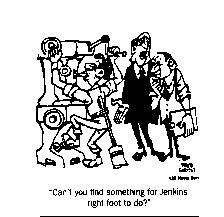
*CAW Auto Parts Benchmarking Study, 1995.

Our bodies aren't made to work endlessly, faster and harder. Machines wear out and so do we. Repetitive Strain Injuries (RSI) are caused by rapid, repetitive motion with insufficient rest. They include sore wrists (tendinitis, tenosynovitis, carpal tunnel syndrome), sore elbows (epicondylitis), and sore shoulders (bursitis, thoracic outlet syndrome).
If we slow down or change our job or stop working at the first signs of symptoms we will avoid permanent damage. If we continue to work in pain we may have a permanent problem.
It seems that now we all know someone who is suffering from an RSI. There are more of us at work wearing a wrist or elbow brace; more of us going for ice treatment; more of us who have trouble with what used to be simple pleasures _ hugging our kids, playing guitar.
The hard evidence is also building. WCB statistics indicate that injuries from repetitive bodily actions are a large and growing problem. The Director of the National Institute for Occupational Safety and Health in the USA has even suggested that by the turn of the century one half of the workforce will have some sort of RSI.
| As well, a major contributing factor to the excessive rate of repetitive strain injuries and back injuries is speed-up at work. Our members are being pushed to work faster and harder by their employers. Short staffing and just-in-time work systems make our workplaces leaner and meaner. Excessive overtime gives our members' bodies less time to repair themselves from the too fast pace of work.
Buzz Hargrove
Day of Mourning, April 28
|
|---|

Stress is our body's 'fight or flight' response to danger. Stress can be caused by environmental factors (heat, noise, chemicals) or by emotional ones (supervisor pushing too hard, jobs which are too fast). Whatever the cause, stress gets physical. Our blood pressure rises, the heart beats faster, breathing increases and adrenalin flows. In the short run stress can give us headaches, indigestion, make us more susceptible to colds or flus. Over time, stress can contribute to ulcers and heart disease.
Our workplaces are stressful. And contrary to the popular notions that executives have stressful jobs, research shows that it is we who have the most stressful working conditions. Whenever there are threats of closure, the insecurity of cut and chop, not enough people to do the job, long hours or too much work, stress goes up. And when stress goes up our health goes down.
There are a number of things we should do to reduce stress and the risk of injuries in our work places.
These include:

The pace of work must be fair and reasonable and our workload accomplished with normal effort. What we can do in the first hour of the shift we should be able to do, comfortably, in the last hour. What the pace of work is today we should be able to do, comfortably, when we are older.
There may be no clear technical answer to what is fair and reasonable but if we work in pain, if we're feeling overloaded, if we can't keep up there is a problem with our workload.
|
|
|---|
Management is intent on making us work harder and faster. In fact most 'continuous improvement' type programs have as their goal _ more work with fewer workers. We must fight for collective agreement provisions which limit employers' rights to speed-up our work.
We need more time for breaks during our shifts. Rest time varies by industry and type of work but there is even considerable difference within the same sector. In the auto industry, for example, rest time during our shift varies from 30 minutes to 56 minutes (excluding lunch); that is a range from under 4 minutes an hour to 7 minutes an hour. Across our union the range is even greater with some workplaces still having two 10 minute breaks, during the entire shift. In responding to speed-up we need to argue for more rest time away from the job. This can take a number of forms:
When the Chrysler mini-van plant was on an eight hour shift, workers in assembly-line based operations had two breaks before lunch (18 minutes & 10 minutes) and two breaks after lunch (18 minutes & 10 minutes) in addition to the 30 minute lunch period.
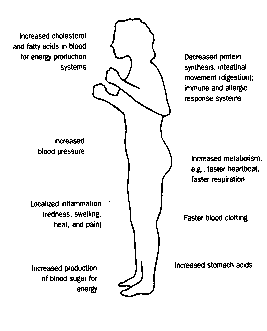
We must demand that workers who are away from work are always replaced. Short staffing is unacceptable.

More of us are getting hurt at work and there are fewer opportunities for light duty work. We must be guaranteed modified work for as long as we need it. If we are injured it isn't acceptable for the employer to place us in someone else's job particularly if they have more seniority. Instead our job must be modified to accommodate our disability and prevent new disabilities. We must negotiate limits to management's ability to redesign or re-engineer our workplaces to get rid of lighter duty jobs.
New technologies provide management more immediate information about work processes. These developments, whether computers, management information systems or video taping, should not be used to monitor workers or measure individual performance. We must demand language that limits the use of intrusive technologies and limits what management can do with the information collected.
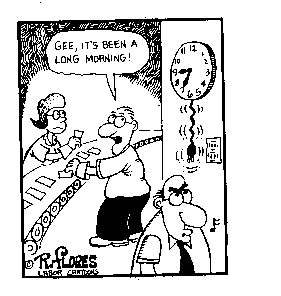
There is a renewed managerial enthusiasm for work method and time systems. Today computerized time systems are being used to calculate job elements, times and even ergonomic factors. These systems are being used to tighten up our jobs. We need collective agreement provisions which provide for:

Ergonomics means changing the equipment, work station, workplace and work organization such as the speed of work to meet workers' needs.
We need provisions in collective agreements which provide:
(1) An ergonomics analysis of every job with ergonomics checklists posted at every work station. We need ergonomic changes to jobs.
(2) The negotiated Joint Health and Safety Committee or an Ergonomics Subcommittee with at least half being union members should be responsible for the ergonomic program including ergonomic evaluation and changes, choice of consultants and education. In large workplaces we need full time union ergonomics reps.
(3) Basic ergonomics education for all workers. A good starting point is the one day MIPP (musculo-skeletal injury prevention program) course.
(4) If outside consultants are used for specific tough problems they must be chosen by the Joint H&S Committee or Ergonomics Subcommittee.
(5) Any time there is a change to the equipment, work station, workplace or work organization there must be an ergonomics evaluation done and changes made if needed.
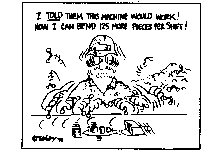

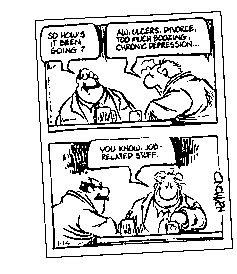
Speed-up problems are made worse if we have too little time to recover. We need sufficient rest. We need recovery time within our job cycles, our work day and our lives.
We must ensure vacations are guaranteed. And we must take our vacations. No employer should be able to persuade workers to take money without taking time off.
We must fight excessive overtime hours. Voluntary overtime must be guaranteed. No employer should be allowed to force workers to work overtime.
We need to work less hours in our lives. Shorter work time can be achieved in a variety of ways: increasing vacation entitlement and making it mandatory, personal days off, long weekends, two weeks training for every worker, fewer hours in the week, and early retirement.
|
"Despite the fact that [she] is an experienced and highly competent sealer applier she must work without a single break in her routine to keep up to the line. It is an accurate observation to say she would not have time to tie her shoe lace, if it came undone." |
|---|

Workers have the right to refuse hazardous work. In every province and territory and in the federal jurisdiction this right is the law. If you are working too hard, too fast, if you are at risk of injury, if you are under stress, you have the right to refuse.
Workers must report the refusal to the supervisor and the union health and safety representative will investigate. If the work is not slowed down to an acceptable pace then the government inspector must be called in. The union rep will insist that the inspector protects our health and safety by supporting the work refusal and writing an order on the employer to slow down the pace of work.
|
|
|---|
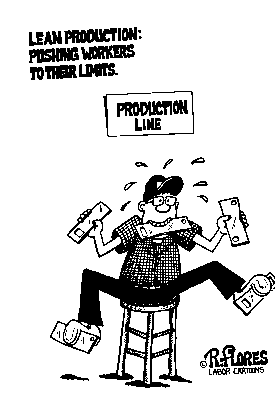
|
|
|---|
Within the past two years our union has made major improvements in contract language dealing with speed-up. The following are just a few of many examples:
In all Big Three (GM, Ford and Chrysler) operations there is a negotiated agreement that industrial engineers use an ergonomic checklist whenever new processes or procedures are introduced or when job assignments change.
As a result of recent negotiations between Local 124, 195, 222, 1986 and A.G. Simpson there will be one member of each plant committee trained at company expense as the Union Time Study representative.
The health and safety committee will evaluate and make recommendations for ergonomically designed work stations for our Local 1498 members employed by Chrysler.
Thomas Built Buses will now have to conduct ergonomics training as a result of the latest collective agreement negotiated with Local 636.
Local 1859 at Del-Tech Metal Products has added ergonomics to the responsibilities of the joint health and safety committee.
Ergonomics subcommittees of the health and safety committees were set up in the last round of bargaining with all Lear Seating plants.
In a first collective agreement between CAW Local 40 and the Bread & Roses Credit union, VDT operators will get 10 minute breaks every hour.
Mastico must assign someone from the Engineering Department to work with the Local 1859 joint health and safety committee to correct ergonomics problems.
Local 195 at Kenden Manufacturing has negotiated an ergonomic umpire to arbitrate disputes.
The agreement between Local 1090 and Lofthouse Brass requires the company to modify an employee's job to accommodate the employee's disability.
"There is no reason why we need to work even harder and faster. We can have productive, effective workplaces which provide high quality goods and services without risking our health or being too exhausted to spend time with our families. It is our collective responsibility to make sure we do.
Understanding the problem of management imposed speed-up is the first step. Action is needed. CAW members in workplaces from coast to coast must resist speed-up.
We will:

Produced by the following departments:
 Click on our logo to to return to the main CAW Digital Collections site
Click on our logo to to return to the main CAW Digital Collections site